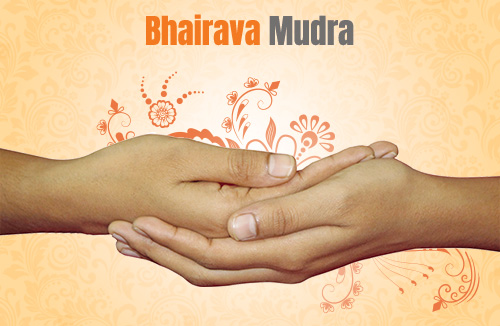Bhairava Mudra

Bhairava Mudra is more than a mere hand gesture; it is a profound practice that harmonizes and balances energy within the body and mind. The term "Bhairava" in Sanskrit translates to "terrible" or "frightful," reflecting the intense energy associated with this mudra. In Hindu mythology, Bhairava is a fierce form of Lord Shiva, known for his role in dispelling ignorance and awakening supreme consciousness.
Bhairava Mudra symbolizes the integration of opposing forces and the transcendence of duality. The right hand, representing masculine energy, is associated with the sun, dynamic action, and willpower. Placing it at the top signifies the integration of these qualities. The left hand, symbolizing feminine energy, is linked to the moon, receptivity, and intuition. Its position underneath represents the grounding and stabilizing of these attributes. It is designed to channel the divine strength and power that Shiva embodies, bringing these qualities to the forefront of our practice.
Benefits of Bhairava Mudra
- Balance Brain Hemispheres: This mudra helps harmonize the left and right hemispheres of the brain, promoting mental clarity and emotional stability.
- Supports Vital Organs: It benefits the heart, stomach, liver, and kidneys, enhancing overall organ function and health.
- Promotes Inner Balance: By creating a sense of inner completeness and calm, Bhairava Mudra helps restore equilibrium and peace within.
- Calms the Breath: The practice of this mudra calms the breath, leading to increased relaxation and reduced stress.
- Activates Five Elements and Chakras: Bhairava Mudra nourishes all five elements, chakras, pranas, doshas, and bodily systems, making it a mudra of pure balance and integration.
- Enhances Wisdom and Unity: It fosters wisdom and promotes unity within oneself, contributing to a deeper understanding of one's inner self.
- Instills Deep Peace: The mudra helps instill a profound sense of peace and inner silence, aiding meditation and spiritual growth.
How to practice Bhairava Mudra
- Sit down on a yoga mat or a chair in a comfortable seated position. Keep your spine straight, and if it helps, close your eyes to enhance focus.
- Place your right hand on top of your left hand, ensuring that the palms of both hands face upward. Alternatively, you can place the backs of your hands on your lap.
- Relax your entire body, keeping it motionless.
- Focus on your breathing—inhale and exhale slowly and deeply. This will help you center your mind and deepen your practice.
Duration of Practice
For optimal benefits, practice Bhairava Mudra for 15 to 45 minutes daily. You can also break it into three 15-minute sessions throughout the day if that fits better into your schedule.
Important caution
- Always practice this hasta mudra on an empty stomach or at least one hour after a meal to achieve the best results.
- For younger practitioners, it’s important to guide them in a simplified manner to ensure comfort and proper execution.
- For older adults, adaptations or modifications may be necessary to accommodate any physical limitations or health conditions.
NEED FURTHER HELP?
If you've a question about Daily Mudras in general or your
mindfulness
practice in particular kindly contact us at